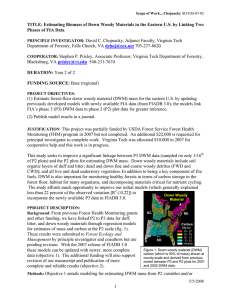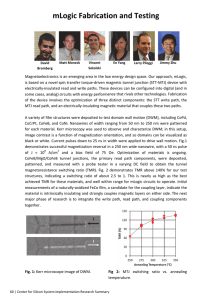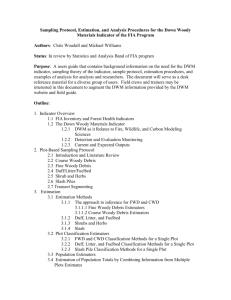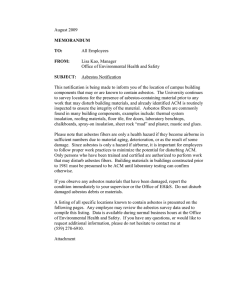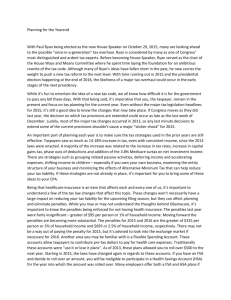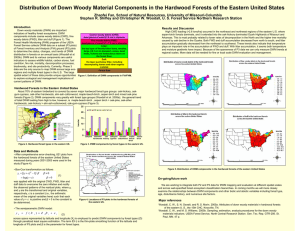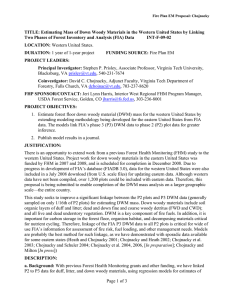Dynamic Weighted Majority: A New Ensemble Method for Tracking
advertisement
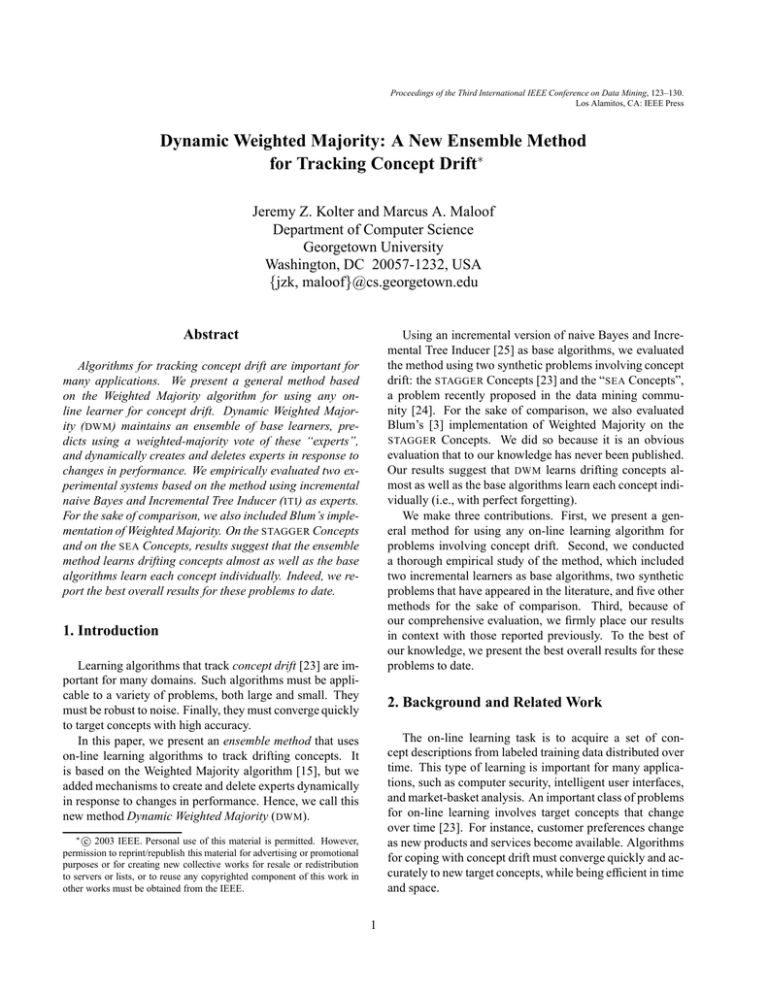
Proceedings of the Third International IEEE Conference on Data Mining, 123–130.
Los Alamitos, CA: IEEE Press
Dynamic Weighted Majority: A New Ensemble Method
for Tracking Concept Drift∗
Jeremy Z. Kolter and Marcus A. Maloof
Department of Computer Science
Georgetown University
Washington, DC 20057-1232, USA
{jzk, maloof}@cs.georgetown.edu
Abstract
Using an incremental version of naive Bayes and Incremental Tree Inducer [25] as base algorithms, we evaluated
the method using two synthetic problems involving concept
drift: the STAGGER Concepts [23] and the “SEA Concepts”,
a problem recently proposed in the data mining community [24]. For the sake of comparison, we also evaluated
Blum’s [3] implementation of Weighted Majority on the
STAGGER Concepts. We did so because it is an obvious
evaluation that to our knowledge has never been published.
Our results suggest that DWM learns drifting concepts almost as well as the base algorithms learn each concept individually (i.e., with perfect forgetting).
We make three contributions. First, we present a general method for using any on-line learning algorithm for
problems involving concept drift. Second, we conducted
a thorough empirical study of the method, which included
two incremental learners as base algorithms, two synthetic
problems that have appeared in the literature, and five other
methods for the sake of comparison. Third, because of
our comprehensive evaluation, we firmly place our results
in context with those reported previously. To the best of
our knowledge, we present the best overall results for these
problems to date.
Algorithms for tracking concept drift are important for
many applications. We present a general method based
on the Weighted Majority algorithm for using any online learner for concept drift. Dynamic Weighted Majority (DWM) maintains an ensemble of base learners, predicts using a weighted-majority vote of these “experts”,
and dynamically creates and deletes experts in response to
changes in performance. We empirically evaluated two experimental systems based on the method using incremental
naive Bayes and Incremental Tree Inducer (ITI) as experts.
For the sake of comparison, we also included Blum’s implementation of Weighted Majority. On the STAGGER Concepts
and on the SEA Concepts, results suggest that the ensemble
method learns drifting concepts almost as well as the base
algorithms learn each concept individually. Indeed, we report the best overall results for these problems to date.
1. Introduction
Learning algorithms that track concept drift [23] are important for many domains. Such algorithms must be applicable to a variety of problems, both large and small. They
must be robust to noise. Finally, they must converge quickly
to target concepts with high accuracy.
In this paper, we present an ensemble method that uses
on-line learning algorithms to track drifting concepts. It
is based on the Weighted Majority algorithm [15], but we
added mechanisms to create and delete experts dynamically
in response to changes in performance. Hence, we call this
new method Dynamic Weighted Majority (DWM).
2. Background and Related Work
The on-line learning task is to acquire a set of concept descriptions from labeled training data distributed over
time. This type of learning is important for many applications, such as computer security, intelligent user interfaces,
and market-basket analysis. An important class of problems
for on-line learning involves target concepts that change
over time [23]. For instance, customer preferences change
as new products and services become available. Algorithms
for coping with concept drift must converge quickly and accurately to new target concepts, while being efficient in time
and space.
∗
c 2003 IEEE. Personal use of this material is permitted. However,
permission to reprint/republish this material for advertising or promotional
purposes or for creating new collective works for resale or redistribution
to servers or lists, or to reuse any copyrighted component of this work in
other works must be obtained from the IEEE.
1
weighting each classifier based on its performance. Several
empirical evaluations suggest that ensembles perform better
than do single classifiers [1, 5, 9, 21].
More recently, there has been work on ensemble methods for on-line learning tasks [8] and for concept drift [24].
Unfortunately, in an on-line setting, it is less clear how to
apply ensemble methods directly. For instance, with bagging, when one new example arrives that is misclassified,
it is too inefficient to resample the available data and learn
new classifiers. One solution is to rely on the user to specify
the number of examples from the input stream for each base
learner [7], but this approach assumes we know a great deal
about the structure of the data stream and is likely to be impractical for drifting concepts. There are on-line boosting
algorithms that reweight classifiers [8], but these assume a
fixed number of classifiers. Again, this could be a strong
assumption when concepts change, but we are unaware of
any on-line boosting approaches that have been applied to
the problem of concept drift.
The Streaming Ensemble Algorithm (SEA) [24] copes
with concept drift with an ensemble of C 4.5 classifiers [22].
SEA reads a fixed amount of data and uses it to create a new
classifier. If this new classifier improves the performance
of the ensemble, then it is added. However, if the ensemble contains the maximum number of classifiers, then the
algorithm replaces a poorly performing classifier with the
new classifier. Performance is measured over the most recent predictions and is based on the performance of both the
ensemble and the new classifier.
Unfortunately, there are problems with this approach.
One is that members of the ensemble stop learning after being formed. This implies that a fixed period of time will
be sufficient for learning all target concepts. In addition, if
concepts drift during this fixed period of time, the learner
may not be able to acquire the new target concepts. Finally,
replacing the worst performing classifier in an unweighted
ensemble may not yield the fastest convergence to new target concepts. In the next section, we describe a new ensemble method that copes with concept drift and addresses
these problems.
Researchers have proposed and evaluated several algorithms for coping with concept drift. STAGGER [23] was
the first designed expressly for concept drift, as were many
of the algorithms that followed, such as FLORA 2 [26], AQ PM [18], AQ 11- PM [19], and AQ 11- PM - WAH [17].
Although researchers have not yet established the degree
to which these algorithms scale to large problems, some
have been designed expressly for learning time-varying
concepts from large data sets [11,24]. Other algorithms are
amendable to such problems because of their formal properties, at least in theory [3, 14, 15]. One such algorithm in
this category is Weighted Majority [15]. It is a method for
weighting and combining the decisions of “experts”, each
of which is a learning method. For instance, Blum [3] used
pairs and triples of features as experts, which returned the
majority vote over the most recent k predictions.
The algorithm begins by creating a set of experts and
assigning a weight to each. When a new instance arrives,
the algorithm passes it to and receives a prediction from
each expert. The algorithm predicts based on a weightedmajority vote of the expert predictions. If an expert incorrectly classifies the example, then the algorithm decreases
its weight by a multiplicative constant. Winnow [14] is similar to Weighted Majority, except that experts may abstain,
and thus have been called “specialists” [3].
Blum [3] evaluated variants of Weighted Majority and
Winnow on a calendar-scheduling task and results suggested that the algorithms responded well to concept drift
and executed fast enough to be useful for real-time applications. However, using pairs of features requires n2 experts,
where n is the number of relevant features (i.e., attributevalue pairs), which makes the direct application of these implementations impractical for most data mining problems.
In one case, when learning the scheduling preferences of
one user using 34 attributes, Weighted Majority and Winnow required 59,731 experts and specialists, respectively.
The advantage of Weighted Majority and Winnow is that
they provide a general scheme for weighting any fixed collection of experts. However, since there are no mechanisms
for dynamically adding or removing new experts or specialists, they are restricted to problems for which we can determine a priori the number required. We provide a remedy
in the next section, and in Section 4.1, we show that by using more sophisticated base algorithms, we can reduce the
number of experts.
Weighted Majority and Winnow are ensemble methods,
and in an off-line setting, such methods create individual
classifiers and combine the predictions of these classifiers
into a single prediction. For example, bagging [4] involves
sampling with replacement from a data set, building a classifier using each sample, and predicting the majority prediction of the individual classifiers. Boosting [9] likewise
creates a series of classifiers, albeit with a different method,
3. DWM: A New Ensemble Method for Concept
Drift
Dynamic Weighted Majority (DWM), shown in Figure 1,
maintains as its concept description an ensemble of learning
algorithms, each referred to as an expert and each with an
associated weight. Given an instance, the performance element polls the experts, each returning a prediction for the
instance. Using these predictions and expert weights, DWM
returns as the global prediction the class label with the highest accumulated weight.
The learning element, given a new training example, first
2
Dynamic-Weighted-Majority ( {~x, y}1n )
{~x, y}1n : training data, feature vector and class label
β : factor for decreasing weights, 0 ≤ β < 1
c ∈ N∗ : number of classes
{e, w}1m : set of experts and their weights
Λ, λ ∈ {1, . . . , c}: global and local predictions
~σ ∈ Rc : sum of weighted predictions for each class
θ: threshold for deleting experts
p: period between expert removal, creation, and
weight update
removes them, and updates their weights (i.e., reduction and
normalization.)
We implemented DWM using two different base learners: an incremental version of naive Bayes and an incremental decision-tree learner. For symbolic attributes, our
incremental version of naive Bayes (NB) stores as its concept description counts for the number of examples of each
class and for each attribute value given the class. Learning, therefore, entails incrementing the appropriate counts
given the new instance. During performance, the algorithm
uses the stored counts to compute the prior probability of
each class, P (Ci ), and the conditional probability of each
attribute value given the class, P (vj |Ci ). Then, under the
assumption that attributes are conditionally independent, it
uses Bayes’ rule to predict the most probable class, C, given
by
Y
P (vj |Ci ).
C = argmax P (Ci )
for i = 1, . . . , n
~σ ← 0
for j = 1, . . . , m
λ = Classify(ej , ~xi )
if (λ 6= yi and i mod p = 0)
wj ← βwj
σλ ← σ λ + w j
end;
Λ = argmaxj σj
if (i mod p = 0)
w ← Normalize-Weights(w)
{e, w} ← Delete-Experts({e, w}, θ)
if (Λ 6= yi )
m←m+1
em ← Create-New-Expert()
wm ← 1
end;
end;
for j = 1, . . . , m
ej ← Train(ej , ~xi )
output Λ
end;
end.
Ci
j
For continuous attributes, our implementation stores for
each class the sum of the attribute values and the sum of
the squared values. Learning simply entails adding an attribute’s value and the square of that value to the appropriate sum. During performance, the implementation uses the
example count and the sums to compute the mean (µ) and
variance (σ 2 ). Then, assuming that the jth attribute’s values
are normally distributed, it computes
P (vj |Ci ) = ∆vj √
1
2πσ 2
e−(vj −µ)
2
/2σ 2
,
where ∆vj is the size of interval in which the random variable for the attribute lies. (See John and Langley [12] for
details.) We will refer to the system with naive Bayes as
DWM - NB .
The Incremental Tree Inducer (ITI) [25] is a complex
algorithm, so we will be unable to describe it fully here.
Briefly, ITI uses as its concept description a decision tree
with only binary tests. In internal nodes, ITI stores frequency counts for symbolic attributes and a list of observed
values for continuous attributes. In leaf nodes, it stores examples. ITI updates a tree by propagating a new example to
a leaf node. During the descent, the algorithm updates the
information at each node, and upon reaching a leaf node,
determines if the tree should be extended by converting the
leaf node to a decision node. A secondary process examines
whether the tests at each node are most appropriate, and if
not, restructures the tree accordingly. We will refer to the
system with ITI as DWM - ITI.
Figure 1. Algorithm for dynamic weighted
majority (DWM).
polls each expert in the manner described previously. If an
expert predicts incorrectly, then its weight is reduced by the
multiplicative constant β.
DWM then determines the global prediction. If it is incorrect, then the algorithm creates a new expert with a weight
of one. The algorithm normalizes expert weights by uniformly scaling them such that the highest weight will be
equal to one. This prevents any newly added experts from
dominating the decision making of existing ones. The algorithm also removes experts with weights less than the
user-defined threshold θ. Finally, DWM passes the training example to each expert’s learning element. Note that
normalizing weights and incrementally training all experts
gives the base learners an opportunity to recover from concept drift. Large and noisy problems required the parameter
p, which governs the frequency that DWM creates experts,
4. Empirical Study and Results
In this section, we present experimental results for DWM and DWM - ITI. We evaluated both systems on the STAG GER Concepts [23], a standard benchmark for evaluating
NB
3
how learners cope with drifting concepts. We also included
Blum’s implementation of Weighted Majority [3] for the
sake of comparison. We know of no published results for
this algorithm on the STAGGER Concepts. Finally, in an effort to determine how our method scales to larger problems
involving concept drift, we also evaluated DWM - NB on the
SEA Concepts [24], a problem recently proposed in the data
mining community.
We did not include any UCI data sets [2] in our evaluation because naive Bayes, ITI, and ensemble methods
in general, have been well studied on many of these tasks
(e.g., [1, 5, 13, 16, 21, 24, 25]). Instead, we chose to evaluate
the methods on problems involving concept drift, on which
their performance is less understood.
Predictive Accuracy (%)
100
80
60
40
DWM-NB
Naive Bayes w/ Perfect Forgetting
Naive Bayes
20
0
0
20
40
60
80
100
120
Time Step (t)
Figure 2. Predictive accuracy for
the STAGGER Concepts.
DWM - NB
on
4.1. The STAGGER Concepts
100
90
Predictive Accuracy (%)
The STAGGER Concepts [23] comprise a standard benchmark for evaluating a learner’s performance in the presence
of concept drift. Each example consists of three attribute
values: color ∈ {green, blue, red }, shape ∈ {triangle, circle, rectangle}, and size ∈ {small, medium, large}. The
presentation of training examples lasts for 120 time steps,
and at each time step, the learner receives one example. For
the first 40 time steps, the target concept is color = red ∧
size = small. During the next 40 time steps, the target concept is color = green ∨ shape = circle. Finally, during the
last 40 time steps, the target concept is size = medium ∨
size = large.
To evaluate the learner, at each time step, one randomly generates 100 examples of the current target concept, presents these to the performance element, and computes the percent correctly predicted. In our experiments,
we repeated this procedure 50 times and averaged the accuracies over these runs. We also computed 95% confidence
intervals.
We evaluated DWM - NB, DWM - ITI, and Blum’s Weighted
Majority [3] with pairs of features as experts on the STAG GER Concepts. All of the Weighted Majority algorithms
halved an expert’s weight when it made a mistake (i.e.,
β = 0.5). For Blum’s Weighted Majority, each expert maintained a history of only its last prediction (i.e., k = 1), under the assumption that this setting would provide the most
reactivity to concept drift. Finally, for DWM, we set it to update its weights and create and remove experts every time
step (i.e., p = 1). The algorithm removed experts when
their weights fell below 0.01 (i.e., θ = 0.01). Pilot studies indicated that these were the optimal settings for p and
k; Varying β affected performance little; The selected value
for θ did not affect accuracy, but did reduce the number of
experts considerably.
For the sake of comparison, in addition to these algorithms, we also evaluated naive Bayes, ITI, naive Bayes
80
70
60
50
40
30
DWM-ITI
ITI w/ Perfect Forgetting
ITI
20
10
0
20
40
60
80
100
120
Time Step (t)
Figure 3. Predictive accuracy for
the STAGGER Concepts.
DWM - ITI
on
with perfect forgetting, and ITI with perfect forgetting. The
“standard” or “traditional” implementations of naive Bayes
and ITI provided a worst-case evaluation, since these systems have not been designed to cope with concept drift and
learn from all examples in the stream regardless of the target concept. The implementations with perfect forgetting,
which is the same as training the methods on each target
concept individually, provided a best-case evaluation, since
the systems were never burdened with examples or concept
descriptions from previous target concepts.
Figure 2 shows the results for DWM - NB on the STAGGER
Concepts. As expected, naive Bayes with perfect forgetting performed the best on all three concepts, while naive
Bayes without forgetting performed the worst. DWM - NB
performed almost as well as naive Bayes with perfect forgetting, which converged more quickly to the target concept. Nonetheless, by time step 40 for all three target concepts, DWM - NB performed almost as well as naive Bayes
with perfect forgetting. (We place these results in context
with related work in the next section.)
DWM - ITI performed similarly, as shown in Figure 3,
4
first target concept, performed comparably on the second,
and performed worse on the third. We evaluated Blum’s
implementation of Weighted Majority that used pairs of features as experts. The STAGGER Concepts consist of three
attributes, each taking one of three possible values. Therefore,
this implementation of Weighted Majority maintained
9
2 = 36 experts throughout the presentation of examples,
as compared to the maximum of six that DWM - NB maintained. Granted, pairs of features are much simpler than the
decision trees that ITI produced, but our implementation of
naive Bayes was quite efficient, maintaining twenty integers for each expert. There were occasions when Weighted
Majority used less memory than did DWM - NB, but we anticipate that using more sophisticated classifiers, such as naive
Bayes, instead of pairs of features, will lead to scalable algorithms, which is the topic of the next section.
7
Expert Count
6
5
4
3
DWM-NB
DWM-ITI
2
1
0
20
40
60
80
100
120
Time Step (t)
Figure 4. Number of experts maintained
for DWM - NB and DWM - ITI on the STAGGER
Concepts.
100
4.2. Performance on a Large Data Set with Drift
Predictive Accuracy (%)
90
80
To determine how well DWM - NB performs on larger
problems involving concept drift, we evaluated it using a
synthetic problem recently proposed in the data mining
community [24]. This problem, which we call the “SEA
Concepts”, consists of three attributes, xi ∈ R such that
0.0 ≤ xi ≤ 10.0. The target concept is x1 + x2 ≤ b, where
b ∈ {7, 8, 9, 9.5}. Thus, x3 is an irrelevant attribute.
The presentation of training examples lasts for 50,000
time steps. For the first fourth (i.e., 12,500 time steps), the
target concept is with b = 8. For the second, b = 9; the
third, b = 7; and the fourth, b = 9.5. For each of these four
periods, we randomly generated a training set consisting of
12,500 examples. In one experimental condition, we added
10% class noise; in another, we did not. We also randomly
generated 2,500 examples for testing. At each time step, we
presented each method with one example, tested the resulting concept descriptions using the examples in the test set,
and computed the percent correct. We repeated this procedure ten times, averaging accuracy over these runs. We also
computed 95% confidence intervals.
On this problem, we evaluated DWM - NB, naive Bayes,
and naive Bayes with perfect forgetting. We set DWM - NB
to halve the expert weights (i.e., β = 0.5) and to update
these weights and to create and remove experts every fifty
time steps (i.e., p = 50). We set the algorithm to remove
experts with weights less than 0.01 (i.e., θ = 0.01).
In Figure 6, we see the predictive accuracies for DWM NB , naive Bayes, and naive Bayes with perfect forgetting on
the SEA Concepts with 10% class noise. As with the STAG GER Concepts, naive Bayes performed the worst, since it
had no method of removing outdated concept descriptions.
Naive Bayes with perfect forgetting performed the best and
represents the best possible performance for this implementation on this problem. DWM - NB achieved accuracies
70
60
50
40
Blum’s Weighted Majority
DWM-ITI
DWM-NB
30
20
0
20
40
60
80
100
120
Time Step (t)
Figure 5. Predictive accuracy for DWM - ITI,
DWM - NB , and Blum’s Weighted Majority on the
STAGGER Concepts.
achieving accuracies nearly as high as ITI with perfect forgetting. DWM - ITI converged more quickly than did DWM NB to the second and third target concepts, but if we compare the plots for naive Bayes and ITI with perfect forgetting, we see that ITI converged more quickly to these target
concepts than did naive Bayes. Thus, the faster convergence
is due to differences in the base learners rather than to something inherent to DWM.
In Figure 4, we present the average number of experts
each system maintained over the fifty runs. On average,
DWM - ITI maintained fewer experts than did DWM - NB , and
we attribute this to the fact that ITI performed better on
the individual concepts than did naive Bayes. Since naive
Bayes made more mistakes than did ITI, DWM - NB created
more experts than did DWM - ITI. We can also see in the figure that the rates of removing experts is roughly the same
for both learners.
Finally, Figure 5 shows the results from the experiment
involving Blum’s implementation of Weighted Majority [3].
This learner outperformed DWM - NB and DWM - ITI on the
5
on the first target concept, DWM - ITI did not perform as well
as did FLORA 2 [26]. However, on the second and third target concepts, it performed notably better than did FLORA 2,
not only in terms of asymptote, but also in terms of slope.
DWM - ITI and AQ - PM [18] performed identically on the
first target concept, but DWM - ITI significantly outperformed
AQ - PM on the second and third concepts, again in terms of
asymptote and slope. AQ 11 [20], although not designed to
cope with concept drift, outperformed DWM - ITI in terms of
asymptote on the first concept and in terms of slope on the
third, but on the second concept, performed significantly
worse than did DWM - ITI [19]. Finally, comparing to AQ 11PM [19] and AQ 11- PM - WAH [17], DWM - ITI did not perform
as well on the first target concept, performed comparably on
the second, and converged more quickly on the third.
Overall, we concluded that DWM - ITI outperformed these
other learners in terms of accuracy, both in slope and
asymptote. In reaching this conclusion, we gave little
weight to performance on the first concept, since most
learners can acquire it easily and doing so requires no mechanisms for coping with drift. On the second and third concepts, with the exception of AQ 11, DWM - ITI performed as
well or better than did the other learners. And while AQ 11
outperformed DWM - ITI in terms of slope on the third concept, this does not mitigate AQ 11’s poor performance on the
second.
We attribute the performance of DWM - ITI to the training of multiple experts on different sequences of examples.
(Weighting experts also contributed, and we will discuss
this topic in detail shortly.) Assume a learner incrementally modifies its concept descriptions as new examples arrive. When the target concept changes, if the new one is
disjoint, then the best policy to learn new descriptions from
scratch, rather than modifying existing ones. This makes
intuitive sense, since the learner does not have to first unlearn the old concept, and results from this and other empirical studies support this assertion [18, 19]. Unfortunately,
target concepts are not always disjoint, it is difficult to determine precisely when concepts change, and it is challenging to identify which rules (or parts of rules) apply to new
target concepts. DWM addresses these problems both by incrementally updating existing descriptions and by learning
new concept descriptions from scratch.
Regarding our results for the SEA Concepts [24], which
we reported in Section 4.2, DWM - NB outperformed SEA on
all four target concepts. On the first concept, performance
was similar in terms of slope, but not in terms of asymptote, and on subsequent concepts, DWM - NB converged more
quickly to the target concepts and did so with higher accuracy. For example, on concepts 2–4, just prior to the
point at which concepts changed, SEA achieved accuracies
in the 90–94% range, while DWM - NB’s were in the 96–98%
range.
100
Predictive Accuracy (%)
95
90
85
80
DWM-NB
Naive Bayes w/ Perfect Forgetting
Naive Bayes
75
70
0
12500
25000
37500
50000
Time Step (t)
Figure 6. Predictive accuracy for DWM - NB on
the SEA Concepts with 10% class noise.
50
DWM-NB, 10% Class Noise
DWM-NB, No Noise
45
40
Expert Count
35
30
25
20
15
10
5
0
0
12500
25000
37500
50000
Time Step (t)
Figure 7. Number of experts maintained for
DWM - NB on the SEA Concepts.
nearly equal to those achieved by naive Bayes with perfect
forgetting.
Finally, Figure 7 shows the number of experts that DWM NB maintained during the runs with and without class noise.
Recall that DWM creates an expert when it misclassifies an
example. In the noisy condition, since 10% of the examples had been relabeled, DWM - NB made more mistakes and
therefore created more experts than it did in the condition
without noise. In the next section, we analyze these results
and place them in context with related work.
5. Analysis and Discussion
In Section 4.1, we presented results for DWM - NB and
on the STAGGER Concepts. In this section, we focus discussion on DWM - ITI, since it performed better than
did DWM - NB on this problem. Researchers have built several systems for coping with concept drift and have evaluated many of them on the STAGGER Concepts. For instance,
DWM - ITI
6
We suspect this is most likely due to SEA’s unweighted
voting procedure and its method of creating and removing
new classifiers. Recall that the method trains a new classifier on a fixed number of examples. If the new classifier
improves the global performance of the ensemble, then it is
added, provided the ensemble does not contain a maximum
number of classifiers; otherwise, SEA replaces a poorly performing classifier in the ensemble with the new classifier.
However, if every classifier in the ensemble has been
trained on a given target concept, and the concept changes
to one that is disjoint, then SEA will have to replace at least
half of the classifiers in the ensemble before accuracy on
the new target concept will surpass that on the old. For instance, if the ensemble consists of 20 classifiers, and each
learns from a fixed set of 500 examples, then it would take
at least 5000 additional training examples before the ensemble contained a majority number of classifiers trained on the
new concept.
In contrast, DWM under similar circumstances requires
only 1500 examples. Assume p = 500, the ensemble consists of 20 fully trained classifiers, all with a weight of
one, and the new concept is disjoint from the previous one.
When an example of this new concept arrives, all 20 classifiers will predict incorrectly, DWM will reduce their weights
to 0.5—since the global prediction is also incorrect—and it
will create a new classifier with a weight of one. It will then
process the next 499 examples.
Assume another example arrives. The original 20 experts will again misclassify the example, and the new expert will predict correctly. Since the weighted prediction of
the twenty will be greater than that of the one, the global
prediction will be incorrect, the algorithm will reduce the
weights of the twenty to 0.25, and it will again create a new
expert with a weight of one. DWM will again process 499
examples.
Assume a similar sequence of events occurs: another example arrives, the original twenty misclassify it, and the two
new ones predict correctly. The weighted-majority vote of
the original twenty will still be greater than that of the new
experts (i.e., 20(0.25) > 2(1)), so DWM will decrease the
weight of the original twenty to 0.125, create a new expert,
and process the next 499 examples. However, at this point,
the three new classifiers trained on the target concept will
be able to overrule the predictions of the original twenty,
since 3(1) > 20(0.125). Crucially, DWM will reach this
state after processing only 1500 examples.
Granted, this analysis of SEA and DWM does not take
into account the convergence of the base learners, and as
such, it is a best-case analysis. The actual number of examples required for both to converge to a new target concept
may be greater, but the relative proportion of examples will
be similar. This analysis also holds if we assume that DWM
replaces experts, rather than creating new ones. Generally,
ensemble methods with weighting mechanisms, like those
present in DWM, will converge more quickly to target concepts (i.e., require fewer examples) than will methods that
replace unweighted learners in the ensemble.
DWM certainly has the potential for creating a large number of experts. We used a simple heuristic that added a
new expert whenever the global prediction was incorrect,
which intuitively, should be problematic for noisy domains.
However, even though on the SEA Concepts DWM - NB maintained as many as 40 experts at, say, time step 37,500, it
maintained only 22 experts on average over the ten runs,
which is similar to the 20–25 that SEA reportedly stored
[24]. If the number of experts were to reach impractical levels, then DWM could simply stop creating experts after obtaining acceptable accuracy; training would continue. Plus,
we could also easily distribute the training of experts to processors on a network or in course-grained parallel machine.
One could argue that better performance of DWM - NB
is due to differences between the base learners. SEA was
an ensemble of C 4.5 classifiers [22], while DWM - NB, of
course, used naive Bayes as the base algorithm. We refuted this hypothesis by running both base learners on each
of the four target concepts. Both achieved comparable accuracies on each concept. For example, on the first target concept, C 4.5 achieved 99% accuracy and naive Bayes
achieved 98%. Since these learners performed similarly, we
concluded that our positive results on this problem were due
not to the superiority of the base learner, but to the mechanisms that create, weight, and remove experts.
6. Concluding Remarks
Tracking concept drift is important for many applications. In this paper, we presented a new ensemble method
based on the Weighted Majority algorithm [15]. Our
method, Dynamic Weighted Majority, creates and removes
base algorithms in response to changes in performance,
which makes it well suited for problems involving concept
drift. We described two implementations of DWM, one with
naive Bayes as the base algorithm, the other with ITI [25].
Using the STAGGER Concepts, we evaluated both methods
and Blum’s implementation of Weighted Majority [3]. To
determine performance on a larger problem, we evaluated
DWM - NB on the SEA Concepts. Results on these problems, when compared to other methods, suggest that DWM
maintained a comparable number of experts, but achieved
higher predictive accuracies and converged to those accuracies more quickly. Indeed, to the best of our knowledge,
these are the best overall results reported for these problems.
In future work, we plan to investigate more sophisticated
heuristics for creating new experts: Rather than creating one
when the global prediction is wrong, perhaps DWM should
take into account the expert’s age or its history of predic7
tions. We would also like to investigate another decisiontree learner as a base algorithm, one that does not maintain encountered examples and that does not periodically
restructure its tree; VFDT [6] is a likely candidate. Although
removing experts of low weight yielded positive results for
the problems we considered in this study, it would be beneficial to investigate mechanisms for explicitly handling noise,
or for determining when examples are likely to be from a
different target concept, such as those based on the Hoeffding bounds [10] present in CVFDT [11]. We anticipate that
these investigations will lead to general, robust, and scalable
ensemble methods for tracking concept drift.
[10] W. Hoeffding. Probability inequalities for sums of bounded
random variables. Journal of the American Statistical Association, 58(301):13–30, 1963.
[11] G. Hulten, L. Spencer, and P. Domingos. Mining timechanging data streams. In Proceedings of the 7th ACM International Conference on Knowledge Discovery and Data
Mining, pages 97–106, ACM Press, New York, NY, 2001.
[12] G. John and P. Langley. Estimating continuous distributions
in Bayesian classifiers. In Proceedings of the 11th Conference on Uncertainty in Artificial Intelligence, pages 338–
345, Morgan Kaufmann, San Francisco, CA, 1995.
[13] R. Kohavi. Scaling up the accuracy of naive-Bayes classifiers: A decision-tree hybrid. In Proceedings of the 2nd International Conference on Knowledge Discovery and Data
Mining, pages 202–207, AAAI Press, Menlo Park, CA,
1996.
[14] N. Littlestone. Learning quickly when irrelevant attributes
abound: A new linear-threshold algorithm. Machine Learning, 2:285–318, 1988.
[15] N. Littlestone and M. Warmuth. The Weighted Majority
algorithm. Information and Computation, 108:212–261,
1994.
[16] R. Maclin and D. Opitz. An empirical evaluation of bagging
and boosting. In Proceedings of the 4th National Conference on Artificial Intelligence, pages 546–551, AAAI Press,
Menlo Park, CA, 1997.
[17] M. Maloof. Incremental rule learning with partial instance
memory for changing concepts. In Proceedings of the International Joint Conference on Neural Networks, pages 2764–
2769, IEEE Press, Los Alamitos, CA, 2003.
[18] M. Maloof and R. Michalski. Selecting examples for partial
memory learning. Machine Learning, 41:27–52, 2000.
[19] M. Maloof and R. Michalski. Incremental learning with partial instance memory. Artificial Intelligence, to appear.
[20] R. Michalski and J. Larson. Incremental generation of VL1
hypotheses: The underlying methodology and the description of program AQ11. Technical Report UIUCDCS-F-83905, Department of Computer Science, University of Illinois, Urbana, 1983.
[21] D. Opitz and R. Maclin. Popular ensemble methods: An
empirical study. Journal of Artificial Intelligence Research,
11:169–198, 1999.
[22] J. Quinlan. C4.5: Programs for machine learning. Morgan
Kaufmann, San Francisco, CA, 1993.
[23] J. Schlimmer and R. Granger. Beyond incremental processing: Tracking concept drift. In Proceedings of the 5th National Conference on Artificial Intelligence, pages 502–507,
AAAI Press, Menlo Park, CA, 1986.
[24] W. Street and Y. Kim. A streaming ensemble algorithm
(SEA) for large-scale classification. In Proceedings of the
7th ACM International Conference on Knowledge Discovery
and Data Mining, pages 377–382, ACM Press, New York,
NY, 2001.
[25] P. Utgoff, N. Berkman, and J. Clouse. Decision tree induction based on efficient tree restructuring. Machine Learning,
29:5–44, 1997.
[26] G. Widmer and M. Kubat. Learning in the presence of concept drift and hidden contexts. Machine Learning, 23:69–
101, 1996.
Acknowledgments. The authors thank William Headden
and the anonymous reviewers for helpful comments on earlier drafts of the manuscript. We also thank Avrim Blum
and Paul Utgoff for releasing their respective systems to
the community. This research was conducted in the Department of Computer Science at Georgetown University.
The work was supported in part by the National Institute
of Standards and Technology under grant 60NANB2D0013
and by the Georgetown Undergraduate Research Opportunities Program.
References
[1] B. Bauer and R. Kohavi. An empirical comparison of voting
classification algorithms: Bagging, boosting, and variants.
Machine Learning, 36:105–139, 1999.
[2] C. Blake and C. Merz. UCI Repository of machine learning databases. Web site, http://www.ics.uci.edu/
~mlearn/MLRepository.html, Department of Information and Computer Sciences, University of California,
Irvine, 1998.
[3] A. Blum. Empirical support for Winnow and WeightedMajority algorithms: Results on a calendar scheduling domain. Machine Learning, 26:5–23, 1997.
[4] L. Breiman. Bagging predictors. Machine Learning,
24:123–140, 1996.
[5] T. Dietterich. An experimental comparison of three methods for constructing ensembles of decision trees: Bagging,
boosting, and randomization. Machine Learning, 40:139–
158, 2000.
[6] P. Domingos and G. Hulten. Mining high-speed data
streams. In Proceedings of the 6th ACM International Conference on Knowledge Discovery and Data Mining, pages
71–80, ACM Press, New York, NY, 2000.
[7] W. Fan, S. Stolfo, and J. Zhang. The application of AdaBoost for distributed, scalable and on-line learning. In
Proceedings of the 5th ACM International Conference on
Knowledge Discovery and Data Mining, pages 362–366,
ACM Press, New York, NY, 1999.
[8] A. Fern and R. Givan. Online ensemble learning: An empirical study. Machine Learning, 53, 2003.
[9] Y. Freund and R. Schapire. Experiments with a new boosting
algorithm. In Proceedings of the 13th International Conference on Machine Learning, pages 148–156, Morgan Kaufmann, San Francisco, CA, 1996.
8

